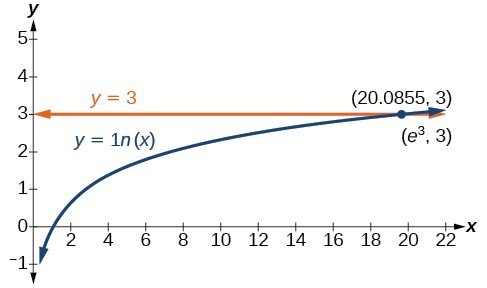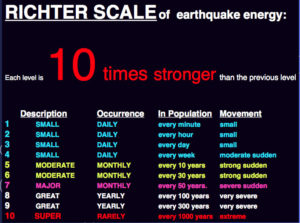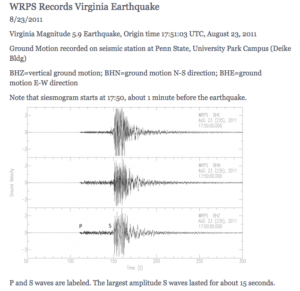Exponential and Logarithmic Equations*
Learning Objectives
- Exponential Equations with Unlike Bases
- Identify an exponential equation whose terms all have the same base
- Idenitfy cases where equations can be rewritten so all terms have the same base
- Apply the one-to-one property of exponents to solve an exponential equation
- Exponential Equations with Unlike Bases
- Use logarithms to solve exponential equations whose terms cannot be rewritten with the same base
- Solve exponential equations of the form [latex]y=A{e}^{kt}[/latex] for t
- Recognize when there may be extraneous solutions, or no solutions for exponential equations
- Logarithmic Equations
- Use the definition of a logarithm to solve logarithmic equations
- Use a graph to verify or analyze the solution to a logarithmic equation
- Applied Exponential and Logarithmic Equations
- Solve half-life problems
- Solve pH problems
- Solve problems involving Richter scale readings
- Solve problems involving decibels
 Wild rabbits in Australia. The rabbit population grew so quickly in Australia that the event became known as the "rabbit plague." (credit: Richard Taylor, Flickr)
Wild rabbits in Australia. The rabbit population grew so quickly in Australia that the event became known as the "rabbit plague." (credit: Richard Taylor, Flickr)Uncontrolled population growth, as in the wild rabbits in Australia, can be modeled with exponential functions. Equations resulting from those exponential functions can be solved to analyze and make predictions about exponential growth. In this section, we will learn techniques for solving exponential functions.
When an exponential equation has the same base on each side, the exponents must be equal. This also applies when the exponents are algebraic expressions. Therefore, we can solve many exponential equations by using the rules of exponents to rewrite each side as a power with the same base. Then, we can set the exponents equal to one another, and solve for the unknown.
For example, consider the equation [latex]{3}^{4x - 7}=\frac{{3}^{2x}}{3}[/latex]. To solve for x, we use the division property of exponents to rewrite the right side so that both sides have the common base, 3. Then we apply the one-to-one property of exponents by setting the exponents equal to one another and solving for x:
Example
Solve [latex]{2}^{x - 1}={2}^{2x - 4}[/latex].Answer: [latex]\begin{array}{c} {2}^{x - 1}={2}^{2x - 4}\hfill & \text{The common base is }2.\hfill \\ \text{ }x - 1=2x - 4\hfill & \text{By the one-to-one property the exponents must be equal}.\hfill \\ \text{ }x=3\hfill & \text{Solve for }x.\hfill \end{array}[/latex]
- Use the rules of exponents to simplify, if necessary, so that the resulting equation has the form [latex]{b}^{S}={b}^{T}[/latex].
- Use the one-to-one property to set the exponents equal.
- Solve the resulting equation, S = T, for the unknown.
Rewriting Equations So All Powers Have the Same Base
Sometimes we can rewrite the terms in an equation as powers with a common base, and solve using the one-to-one property. This takes a keen eye for recognizing common powers. For example, you can rewrite 8 as [latex]2^3[/latex] or 36 as [latex]6^2[/latex] or [latex]\frac{1}{4}[/latex] as [latex]\left(\frac{1}{2}\right)^{2}[/latex]
Consider the equation [latex]256={4}^{x - 5}[/latex]. We can rewrite both sides of this equation as a power of 2. Then we apply the rules of exponents, along with the one-to-one property, to solve for x:
Example
Solve [latex]{8}^{x+2}={16}^{x+1}[/latex].Answer: [latex]\begin{array}{c}\text{ }{8}^{x+2}={16}^{x+1}\hfill & \hfill \\ {\left({2}^{3}\right)}^{x+2}={\left({2}^{4}\right)}^{x+1}\hfill & \text{Write }8\text{ and }16\text{ as powers of }2.\hfill \\ \text{ }{2}^{3x+6}={2}^{4x+4}\hfill & \text{To take a power of a power, multiply exponents}.\hfill \\ \text{ }3x+6=4x+4\hfill & \text{Use the one-to-one property to set the exponents equal}.\hfill \\ \text{ }x=2\hfill & \text{Solve for }x.\hfill \end{array}[/latex]
Example
Solve [latex]{2}^{5x}=\sqrt{2}[/latex].Answer: [latex]\begin{array}{c}{2}^{5x}={2}^{\frac{1}{2}}\hfill & \text{Write the square root of 2 as a power of }2.\hfill \\ 5x=\frac{1}{2}\hfill & \text{Use the one-to-one property}.\hfill \\ x=\frac{1}{10}\hfill & \text{Solve for }x.\hfill \end{array}[/latex]
- Rewrite each side in the equation as a power with a common base.
- Use the rules of exponents to simplify, if necessary, so that the resulting equation has the form [latex]{b}^{S}={b}^{T}[/latex].
- Use the one-to-one property to set the exponents equal.
- Solve the resulting equation, S = T, for the unknown.
Think About It
Do all exponential equations have a solution? If not, how can we tell if there is a solution during the problem-solving process? Write your thoughts in the textbox below before you check our proposed answer. [practice-area rows="1"][/practice-area]Answer: No. Recall that the range of an exponential function is always positive. While solving the equation, we may obtain an expression that is undefined.
Example
Solve [latex]{3}^{x+1}=-2[/latex].Answer: This equation has no solution. There is no real value of x that will make the equation a true statement because any power of a positive number is positive. For example [latex]3^2=9[/latex], and [latex]2^4=16[/latex]. Remember that we have defined exponential functions as having a base that is greater than 0.
Analysis of the Solution
Exponential Equations with unlike Bases
Sometimes the terms of an exponential equation cannot be rewritten with a common base. In these cases, we solve by taking the logarithm of each side. Recall, since [latex]\mathrm{log}\left(a\right)=\mathrm{log}\left(b\right)[/latex] is equivalent to a = b, we may apply logarithms with the same base on both sides of an exponential equation. In our first example we will use the law of logs combined with factoring to solve an exponential equation whose terms do not have the same base. Note how first, we rewrite the exponential terms as logarithms.Example
Solve [latex]{5}^{x+2}={4}^{x}[/latex].Answer: There is no easy way to get the powers to have the same base for this equation.
[latex]\begin{array}{c}\text{ }{5}^{x+2}={4}^{x}. \\ \text{ }\mathrm{ln}{5}^{x+2}=\mathrm{ln}{4}^{x}\hfill & \text{Take ln of both sides}.\hfill \\ \text{ }\left(x+2\right)\mathrm{ln}5=x\mathrm{ln}4\hfill & \text{Use laws of logs}.\hfill \\ \text{ }x\mathrm{ln}5+2\mathrm{ln}5=x\mathrm{ln}4\hfill & \text{Use the distributive law}.\hfill \\ \text{ }x\mathrm{ln}5-x\mathrm{ln}4=-2\mathrm{ln}5\hfill & \text{Get terms containing }x\text{ on one side, terms without }x\text{ on the other}.\hfill \\ x\left(\mathrm{ln}5-\mathrm{ln}4\right)=-2\mathrm{ln}5\hfill & \text{On the left hand side, factor out an }x.\hfill \\ \text{ }x\mathrm{ln}\left(\frac{5}{4}\right)=\mathrm{ln}\left(\frac{1}{25}\right)\hfill & \text{Use the laws of logs}.\hfill \\ \text{ }x=\frac{\mathrm{ln}\left(\frac{1}{25}\right)}{\mathrm{ln}\left(\frac{5}{4}\right)}\hfill & \text{Divide by the coefficient of }x.\hfill \end{array}[/latex]
- Apply the logarithm of both sides of the equation.
- If one of the terms in the equation has base 10, use the common logarithm.
- If none of the terms in the equation has base 10, use the natural logarithm.
- Use the rules of logarithms to solve for the unknown.
Think About It
Is there any way to solve [latex]{2}^{x}={3}^{x}[/latex]? Use the textbox below to formulate an answer or example before you look at the solution. [practice-area rows="1"][/practice-area]Answer: Yes. The solution is x = 0.
Equations Containing [latex]e[/latex]
Example
Solve [latex]100=20{e}^{2t}[/latex].Answer: [latex]\begin{array}{c}100\hfill & =20{e}^{2t}\hfill & \hfill \\ 5\hfill & ={e}^{2t}\hfill & \text{Divide by the coefficient of the power}\text{.}\hfill \\ \mathrm{ln}5\hfill & =2t\hfill & \text{Take ln of both sides}\text{. Use the fact that }\mathrm{ln}\left(x\right)\text{ and }{e}^{x}\text{ are inverse functions}\text{.}\hfill \\ t\hfill & =\frac{\mathrm{ln}5}{2}\hfill & \text{Divide by the coefficient of }t\text{.}\hfill \end{array}[/latex]
Analysis of the Solution
Using laws of logs, we can also write this answer in the form [latex]t=\mathrm{ln}\sqrt{5}[/latex]. If we want a decimal approximation of the answer, we use a calculator.Think About It
Does every equation of the form [latex]y=A{e}^{kt}[/latex] have a solution? Write your thoughts or an example in the textbox below before you check the answer. [practice-area rows="1"][/practice-area]Answer: No. There is a solution when [latex]k\ne 0[/latex], and when y and A are either both 0 or neither 0, and they have the same sign. An example of an equation with this form that has no solution is [latex]2=-3{e}^{t}[/latex].
Example
Solve [latex]4{e}^{2x}+5=12[/latex].Answer: [latex]\begin{array}{c}4{e}^{2x}+5=12\hfill & \hfill \\ 4{e}^{2x}=7\hfill & \text{Combine like terms}.\hfill \\ {e}^{2x}=\frac{7}{4}\hfill & \text{Divide by the coefficient of the power}.\hfill \\ 2x=\mathrm{ln}\left(\frac{7}{4}\right)\hfill & \text{Take ln of both sides}.\hfill \\ x=\frac{1}{2}\mathrm{ln}\left(\frac{7}{4}\right)\hfill & \text{Solve for }x.\hfill \end{array}[/latex]
Extraneous Solutions
Sometimes the methods used to solve an equation introduce an extraneous solution, which is a solution that is correct algebraically but does not satisfy the conditions of the original equation. One such situation arises in solving when the logarithm is taken on both sides of the equation. In such cases, remember that the argument of the logarithm must be positive. If the number we are evaluating in a logarithm function is negative, there is no output.
In the next example we will solve an exponential equation that is quadratic in form. We will factor first and then use the zero product principle. Note how we find two solutions, but reject one that does not satisfy the original equaiton.Example
Solve [latex]{e}^{2x}-{e}^{x}=56[/latex].Answer: [latex]\begin{array}{c}{e}^{2x}-{e}^{x}\hfill & =56\hfill & \hfill \\ {e}^{2x}-{e}^{x}-56\hfill & =0\hfill & \text{Get one side of the equation equal to zero}.\hfill \\ \left({e}^{x}+7\right)\left({e}^{x}-8\right)\hfill & =0\hfill & \text{Factor by the FOIL method}.\hfill \\ {e}^{x}+7\hfill & =0\text{ or }{e}^{x}-8=0 & \text{If a product is zero, then one factor must be zero}.\hfill \\ {e}^{x}\hfill & =-7{\text{ or e}}^{x}=8\hfill & \text{Isolate the exponentials}.\hfill \\ {e}^{x}\hfill & =8\hfill & \text{Reject the equation in which the power equals a negative number}.\hfill \\ x\hfill & =\mathrm{ln}8\hfill & \text{Solve the equation in which the power equals a positive number}.\hfill \end{array}[/latex]
Analysis of the Solution
When we plan to use factoring to solve a problem, we always get zero on one side of the equation, because zero has the unique property that when a product is zero, one or both of the factors must be zero. We reject the equation [latex]{e}^{x}=-7[/latex] because a positive number never equals a negative number. The solution [latex]x=\mathrm{ln}\left(-7\right)[/latex] is not a real number, and in the real number system this solution is rejected as an extraneous solution.
Think About It
Does every logarithmic equation have a solution? Write your ideas, or a counter example in the box below. [practice-area rows="1"][/practice-area]Answer: No. Keep in mind that we can only apply the logarithm to a positive number. Always check for extraneous solutions.
Logarithmic Equations
We have already seen that every logarithmic equation [latex]{\mathrm{log}}_{b}\left(x\right)=y[/latex] is equivalent to the exponential equation [latex]{b}^{y}=x[/latex]. We can use this fact, along with the rules of logarithms, to solve logarithmic equations where the argument is an algebraic expression.For example, consider the equation [latex]{\mathrm{log}}_{2}\left(2\right)+{\mathrm{log}}_{2}\left(3x - 5\right)=3[/latex]. To solve this equation, we can use rules of logarithms to rewrite the left side in compact form and then apply the definition of logs to solve for x:
Example
Solve [latex]2\mathrm{ln}x+3=7[/latex].Answer: [latex]\begin{array}{c}2\mathrm{ln}x+3=7\hfill & \hfill \\ \text{ }2\mathrm{ln}x=4\hfill & \text{Subtract 3}.\hfill \\ \text{ }\mathrm{ln}x=2\hfill & \text{Divide by 2}.\hfill \\ \text{ }x={e}^{2}\hfill & \text{Rewrite in exponential form}.\hfill \end{array}[/latex]
Analysis of the solution
The solution for the previous equation was [latex]x={e}^{2}[/latex], this is often referred to as the exact solution. Sometimes, you may be asked to give an approximation, which would be more useful to someone using the result for a financial, scientific or engineering application. The approximation for [latex]x={e}^{2}[/latex] can be found with a calculator. [latex]x={e}^{2}\approx{7.4}[/latex] In general, we can describe using the definition of a logarithm to solve logarithmic equations as follows:For any algebraic expression S and real numbers b and c, where [latex]b>0,\text{ }b\ne 1[/latex],
Example
Solve [latex]2\mathrm{ln}\left(6x\right)=7[/latex].Answer: [latex]\begin{array}{c}2\mathrm{ln}\left(6x\right)=7\hfill & \hfill \\ \text{ }\mathrm{ln}\left(6x\right)=\frac{7}{2}\hfill & \text{Divide by 2}.\hfill \\ \text{ }6x={e}^{\left(\frac{7}{2}\right)}\hfill & \text{Use the definition of }\mathrm{ln}.\hfill \\ \text{ }x=\frac{1}{6}{e}^{\left(\frac{7}{2}\right)}\hfill & \text{Divide by 6}.\hfill \end{array}[/latex]
Answer
Exact answer: [latex]x=\frac{1}{6}{e}^{\left(\frac{7}{2}\right)}[/latex] Approximate answer: [latex]x\approx{5.5}[/latex]Example
Solve [latex]\mathrm{ln}x=3[/latex].Answer:
[latex]\begin{array}{c}\mathrm{ln}x=3\hfill & \hfill \\ x={e}^{3}\hfill & \text{Use the definition of the natural logarithm}\text{.}\hfill \end{array}[/latex]
The graph below represents the graph of the equation. On the graph, the x-coordinate of the point at which the two graphs intersect is close to 20. In other words [latex]{e}^{3}\approx 20[/latex]. A calculator gives a better approximation: [latex]{e}^{3}\approx 20.0855[/latex].

Use the one-to-one property of logarithms to solve logarithmic equations
As with exponential equations, we can use the one-to-one property to solve logarithmic equations. The one-to-one property of logarithmic functions tells us that, for any real numbers x > 0, S > 0, T > 0 and any positive real number b, where [latex]b\ne 1[/latex],
For example,
So, if [latex]x - 1=8[/latex], then we can solve for x, and we get x = 9. To check, we can substitute x = 9 into the original equation: [latex]{\mathrm{log}}_{2}\left(9 - 1\right)={\mathrm{log}}_{2}\left(8\right)=3[/latex]. In other words, when a logarithmic equation has the same base on each side, the arguments must be equal. This also applies when the arguments are algebraic expressions. Therefore, when given an equation with logs of the same base on each side, we can use rules of logarithms to rewrite each side as a single logarithm. Then we use the fact that logarithmic functions are one-to-one to set the arguments equal to one another and solve for the unknown.
Example
Solve [latex]\mathrm{log}\left(3x - 2\right)-\mathrm{log}\left(2\right)=\mathrm{log}\left(x+4\right)[/latex] Check your results.Answer: [latex]\begin{array}{c}\mathrm{log}\left(3x - 2\right)-\mathrm{log}\left(2\right)=\mathrm{log}\left(x+4\right)\hfill & \hfill \\ \text{ }\mathrm{log}\left(\frac{3x - 2}{2}\right)=\mathrm{log}\left(x+4\right)\hfill & \text{Apply the quotient rule of logarithms}.\hfill \\ \text{ }\frac{3x - 2}{2}=x+4\hfill & \text{Apply the one to one property of a logarithm}.\hfill \\ \text{ }3x - 2=2x+8\hfill & \text{Multiply both sides of the equation by }2.\hfill \\ \text{ }x=10\hfill & \text{Subtract 2}x\text{ and add 2}.\hfill \end{array}[/latex]
To check the result, substitute x = 10 into [latex]\mathrm{log}\left(3x - 2\right)-\mathrm{log}\left(2\right)=\mathrm{log}\left(x+4\right)[/latex].
Answer
x = 10- Use the rules of logarithms to combine like terms, if necessary, so that the resulting equation has the form [latex]{\mathrm{log}}_{b}S={\mathrm{log}}_{b}T[/latex].
- Use the one-to-one property to set the arguments equal.
- Solve the resulting equation, S = T, for the unknown.
Example
[latex-display]{\mathrm{log}}_{b}S={\mathrm{log}}_{b}T\text{ if and only if }S=T[/latex-display]Answer: [latex]\begin{array}{c}\text{ }\mathrm{ln}\left({x}^{2}\right)=\mathrm{ln}\left(2x+3\right)\hfill & \hfill \\ \text{ }{x}^{2}=2x+3\hfill & \text{Use the one-to-one property of the logarithm}.\hfill \\ \text{ }{x}^{2}-2x - 3=0\hfill & \text{Get zero on one side before factoring}.\hfill \\ \left(x - 3\right)\left(x+1\right)=0\hfill & \text{Factor using FOIL}.\hfill \\ \text{ }x - 3=0\text{ or }x+1=0\hfill & \text{If a product is zero, one of the factors must be zero}.\hfill \\ \text{ }x=3\text{ or }x=-1\hfill & \text{Solve for }x.\hfill \end{array}[/latex]
Analysis of the Solution
There are two solutions: x = 3 or x = –1. The solution x = –1 is negative, but it checks when substituted into the original equation because the argument of the logarithm functions is still positive.
Applications of Logarithmic EquationsIn previous sections, we learned the properties and rules for both exponential and logarithmic functions. We have seen that any exponential function can be written as a logarithmic function and vice versa. We have used exponents to solve logarithmic equations and logarithms to solve exponential equations. We are now ready to combine our skills to solve equations that model real-world situations, whether the unknown is in an exponent or in the argument of a logarithm.

One such application is called half-life, which refers to the amount of time it takes for half a given quantity of radioactive material to decay. The table below lists the half-life for several of the more common radioactive substances.
| Substance | Use | Half-life |
|---|---|---|
| gallium-67 | nuclear medicine | 80 hours |
| cobalt-60 | manufacturing | 5.3 years |
| technetium-99m | nuclear medicine | 6 hours |
| americium-241 | construction | 432 years |
| carbon-14 | archeological dating | 5,715 years |
| uranium-235 | atomic power | 703,800,000 years |
We can see how widely the half-lives for these substances vary. Knowing the half-life of a substance allows us to calculate the amount remaining after a specified time. We can use the formula for radioactive decay:
where
- [latex]{A}_{0}[/latex] is the amount initially present
- T is the half-life of the substance
- t is the time period over which the substance is studied
- [latex]A(t)[/latex] is the amount of the substance present after time t
Example
How long will it take for ten percent of a 1000-gram sample of uranium-235 to decay?Answer: [latex]\begin{array}{c}\text{ }y=\text{1000}e\frac{\mathrm{ln}\left(0.5\right)}{\text{703,800,000}}t\hfill & \hfill \\ \text{ }900=1000{e}^{\frac{\mathrm{ln}\left(0.5\right)}{\text{703,800,000}}t}\hfill & \text{After 10% decays, 900 grams are left}.\hfill \\ \text{ }0.9={e}^{\frac{\mathrm{ln}\left(0.5\right)}{\text{703,800,000}}t}\hfill & \text{Divide by 1000}.\hfill \\ \mathrm{ln}\left(0.9\right)=\mathrm{ln}\left({e}^{\frac{\mathrm{ln}\left(0.5\right)}{\text{703,800,000}}t}\right)\hfill & \text{Take ln of both sides}.\hfill \\ \mathrm{ln}\left(0.9\right)=\frac{\mathrm{ln}\left(0.5\right)}{\text{703,800,000}}t\hfill & \text{ln}\left({e}^{M}\right)=M\hfill \\ \text{ }\text{ }t=\text{703,800,000}\times \frac{\mathrm{ln}\left(0.9\right)}{\mathrm{ln}\left(0.5\right)}\text{years}\begin{array}{c}{cccc}& & & \end{array}\hfill & \text{Solve for }t.\hfill \\ \text{ }\text{ }t\approx \text{106,979,777 years}\hfill & \hfill \end{array}[/latex]
Analysis of the Solution
Ten percent of 1000 grams is 100 grams. If 100 grams decay, the amount of uranium-235 remaining is 900 grams.
pH
 In chemistry, pH is used as a measure of the acidity or alkalinity of a substance. The pH scale runs from 0 to 14. Substances with a pH less than 7 are considered acidic, and substances with a pH greater than 7 are said to be alkaline. In our next example we will find how doubling the concentration of hydrogen ions in a liquid affects pH.
In chemistry, pH is used as a measure of the acidity or alkalinity of a substance. The pH scale runs from 0 to 14. Substances with a pH less than 7 are considered acidic, and substances with a pH greater than 7 are said to be alkaline. In our next example we will find how doubling the concentration of hydrogen ions in a liquid affects pH.
Example
In chemistry, [latex]\text{pH}=-\mathrm{log}\left[{H}^{+}\right][/latex]. If the concentration of hydrogen ions in a liquid is doubled, what is the effect on pH?Answer:
Suppose C is the original concentration of hydrogen ions, and P is the original pH of the liquid. Then [latex]P=-\mathrm{log}\left(C\right)[/latex]. If the concentration is doubled, the new concentration is 2C. Then the pH of the new liquid is
Using the product rule of logs
Since [latex]P=-\mathrm{log}\left(C\right)[/latex], the new pH is
When the concentration of hydrogen ions is doubled, the pH decreases by about 0.301.
Richter Scale
 Richter Scale of Earthquake Energy
Richter Scale of Earthquake Energy[latex]R=\mathrm{log}\left(\frac{A}{A_{0}}\right)[/latex]
The intensity of an earthquake will typically measure between 2 and 10 on the Richter scale. Any earthquakes registering below a 5 are fairly minor; they may shake the ground a bit, but are seldom strong enough to cause much damage. Earthquakes with a Richter rating of between 5 and 7.9 are much more severe, and any quake above an 8 is likely to cause massive damage. (The highest rating ever recorded for an earthquake is 9.5 during the 1960 Valdivia earthquake in Chile.)Example
An earthquake is measured with a wave amplitude 392 times as great as [latex]A_{0}[/latex]. What is the magnitude of this earthquake using the Richter scale, to the nearest tenth?Answer: Use the Richter scale equation. [latex-display]R=\mathrm{log}\left(\frac{A}{A_{0}}\right)[/latex-display] Since A is 392 times as large as[latex]A_{0}[/latex], [latex]A=392A_{0}[/latex]. Substitute this expression in for A. [latex-display]R=\mathrm{log}\left(\frac{392A_{0}}{A_{0}}\right)[/latex-display] Simplify the argument of the logarithm, then use a calculator to evaluate. [latex-display]\begin{array}{c}R=\mathrm{log}\left(\frac{392A_{0}}{A_{0}}\right)\\=\mathrm{log}\left(392\right)\\=2.5932\\\approx{2.6}\end{array}[/latex-display]
Answer
The earthquake registered 2.6 on the Richter scale.Decibels
[latex]d=10\mathrm{log}\left(\frac{P}{P_{0}}\right)[/latex]
where P is the power or intensity of the sound and P0 is the weakest sound that the human ear can hear. In the next example we will find how much more intense the noise from a dishwasher is than the noise from a hot water pump.Example
One hot water pump has a noise rating of 50 decibels. One dishwasher, however, has a noise rating of 62 decibels. The dishwasher noise is how many times more intense than the hot water pump noise?Answer: You can’t easily compare the two noises using the formula, but you can compare them to [latex]P_{0}[/latex]. Start by finding the intensity of noise for the hot water pump. Use h for the intensity of the hot water pump’s noise.
[latex]50=10\mathrm{log}\left(\frac{h}{P_{0}}\right)[/latex]
Divide the equations by 10 to get the log by itself.[latex]5=\mathrm{log}\left(\frac{h}{P_{0}}\right)[/latex]
Rewrite the equation as an exponential equation.[latex]10^5=\frac{h}{P_{0}}[/latex]
Solve for h, the intensity of the water pump.
[latex]h=P_{0}10^5[/latex]
Repeat the same process to find the intensity of the noise for the dishwasher, use d to represent the intensity of the sound of the dishwasher. Remember that [latex]{P_{0}}[/latex] is a baseline for the most faint sound the human ear can hear.[latex]\begin{array}{c}62=10\mathrm{log}\left(\frac{d}{P_{0}}\right)\\6.2=\mathrm{log}\left(\frac{d}{P_{0}}\right)\\10^{6.2}=\frac{d}{P_{0}}\\d=P_{0}10^{6.2}\end{array}[/latex]
To compare d to h, you can divide. (Think: if the dishwasher’s noise is twice as intense as the pump’s, then d should be 2h—that is, [latex]\frac{d}{h}[/latex] should be 2.) Use the laws of exponents to simplify the quotient.[latex]\Large\frac{d}{h}=\frac{P_{0}10^{6.2}}{P_{0}10^5}=\frac{10^{6.2}}{10^{5}}=\normalsize10^{6.2-5}=10^{1.2}[/latex]
Answer
The dishwasher’s noise is [latex]10^{1.2}[/latex] (or about 15.85) times as intense as the hot water pump.Summary
Put it Together
 Ground Motion recorded on seismic station at Penn State, University Park Campus (Deike Bldg)
Ground Motion recorded on seismic station at Penn State, University Park Campus (Deike Bldg)The Alaska quake of 1964 had a Richter scale value of 8.5, how many times greater than baseline was the measured wave amplitude recorded by a seismograph?
[latex]8.5=\mathrm{log}\left(\frac{A}{A_{0}}\right)[/latex]
He was so excited to have found something he and Joan could talk about, he beamed when he saw that she had a problem for him to solve.
"I probably knew how to solve that once, but it has been a long time," said Grandpa. "Will you show me?"
First, Joan explained to her grandpa that the goal of the problem was to get the argument out of the logarithm. She remembered that a logarithm is an exponent, so her first step was to rewrite the logarithm as an exponential:
[latex]\begin{array}{c}8.5=\mathrm{log}\left(\frac{A}{A_{0}}\right)\\{10}^{8.5}=\frac{A}{A_{0}}\\{10}^{8.5}\cdot{A_{0}}={A}\end{array}[/latex]
Joan entered [latex]{10}^{8.5}[/latex] into a calculator and got the following number:
[latex]316,227,766.017[/latex]
Wow, the amplitude of the waves that caused the Alaska earthquake of 1964 was 3 million times greater than the baseline reading!
When working with values that are very large or very small, it is very helpful to work in logarithmic or exponential scales. It helps scientists avoid having to do calculations with massive numbers. Additionally, it makes comparisons between different measurements easier to understand.
Joan had such a good time explaining to Grandpa how the math problem worked, she forgot all about having stumped him. Later that night, Hobbes didn't wake her up as he let himself out of the window and down the ladder Anne and Joan made for him. And Joan was happily saving away for the graduation trip that she was planning to take with Hazel (and maybe even her next dreamy boyfriend). Algebra kept Joan from driving while intoxicated, taught her how food poisoning worked, and even helped her choose a good cell phone plan. But this isn't what Joan will remember now that she's finished her math class. What she'll remember is that she now has the power and knowledge to figure out solutions to so many of the challenges in her real life. And we hope you remember that, too! (Don't worry; if you forget some of the math rules along the way, you can always check back and refresh your memory. We'll be waiting.)
Licenses & Attributions
CC licensed content, Original
- Revision and Adaptation. Provided by: Lumen Learning License: CC BY: Attribution.
- Screenshot: WRPS Records Virginia Earthquake. Provided by: Lumen Learning License: CC BY: Attribution.
CC licensed content, Shared previously
- Precalculus. Provided by: OpenStax Authored by: Jay Abramson, et al.. Located at: https://openstax.org/books/precalculus/pages/1-introduction-to-functions. License: CC BY: Attribution.
- Lemon. Authored by: Andru00e9 Karwath. Located at: https://commons.wikimedia.org/w/index.php?curid=59992. License: CC BY-SA: Attribution-ShareAlike.
- Earthquake_Richter_Scale. Authored by: Webber. Located at: https://commons.wikimedia.org/w/index.php?curid=1567023. License: Public Domain: No Known Copyright.
- 1964 Alaska earthquake. Provided by: Wikipedia Located at: https://en.wikipedia.org/wiki/1964_Alaska_earthquake. License: CC BY-SA: Attribution-ShareAlike.

The figure below shows the graphs of the two separate expressions in the equation [latex]{3}^{x+1}=-2[/latex] as [latex]y={3}^{x+1}[/latex] and [latex]y=-2[/latex]. The two graphs do not cross showing us that the left side is never equal to the right side. Thus the equation has no solution.